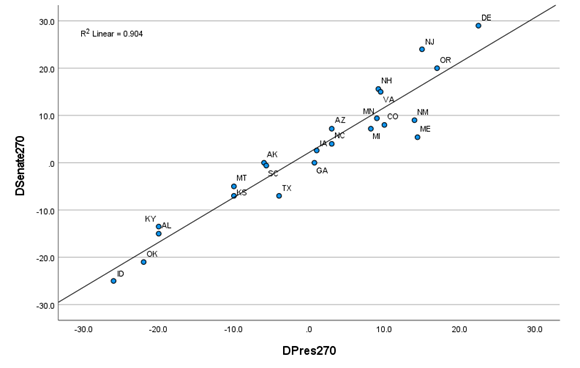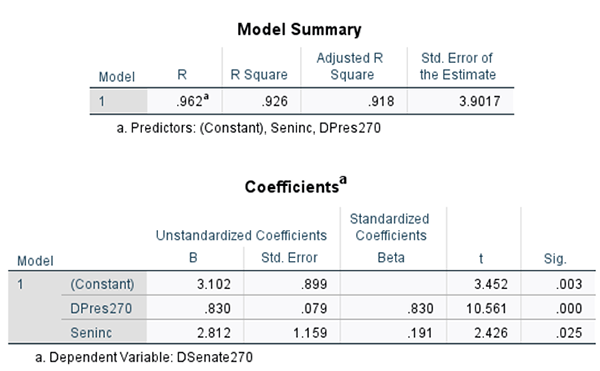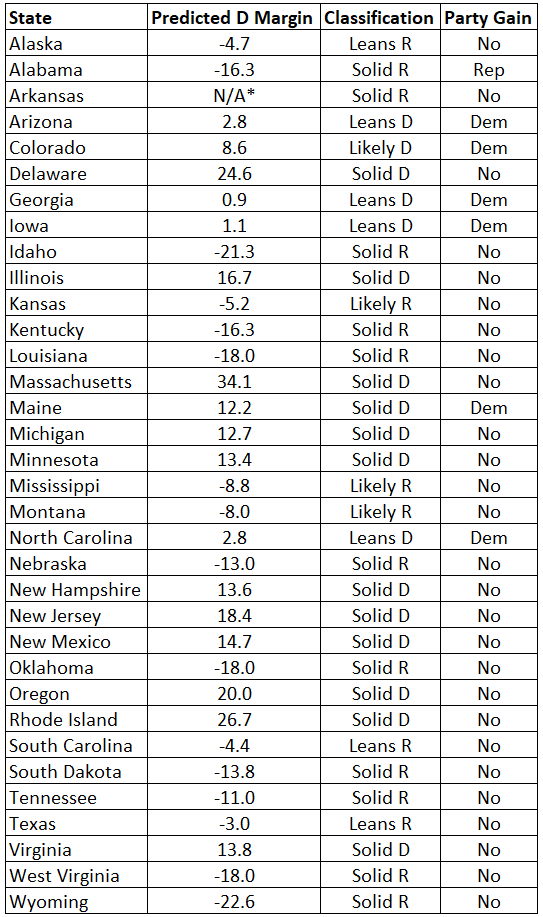| Dear Readers: On Thursday’s 2 p.m. edition of Sabato’s Crystal Ball: America Votes, we’ll go in-depth on the race for the Senate. We’ll also be joined by a special guest: Grace Panetta of Business Insider. The election has already started, with millions of votes already cast: Grace is closely following these trends and will give us an update on changes in how people vote and what those changes might tell us about the results.
If you have questions you would like us to answer about early voting, specific races, or other developments in the campaign, email us at [email protected]. Additionally, an audio-only podcast version of the webinar is now available at Apple Podcasts, Spotify, and other podcast providers. Search “Sabato’s Crystal Ball” to find it. You can watch live at our YouTube channel (UVACFP), as well as at this direct YouTube link. — The Editors |
KEY POINTS FROM THIS ARTICLE
— Senate elections have become increasingly tied to presidential voting results.
— This shows up in this year’s polling, as the margins for states’ presidential and Senate races are closely linked.
— An analysis of these polling data suggest that Democrats are likely to achieve a net gain of between one and eight seats with the most likely result a net gain of five seats, enough to give them a small Senate majority.
Nationalized Senate elections
Over the past three decades, U.S. Senate elections have become increasingly nationalized. Presidential coattails have always been a factor in Senate elections, but the connection between presidential and Senate elections is much closer now than in the past. This trend reflects rising partisan polarization and straight-ticket voting. Thus, in 2016, for the first time in modern history, the candidate of the winning presidential candidate in the state won every Senate contest.
There is every reason to expect that the 2020 Senate elections will continue this trend. The overwhelming majority of voters have strong opinions about President Trump, and Republican and Democratic Senate candidates are generally emphasizing their support or opposition to the president and his policies in their campaigns. We expect to find a very close connection between the 2020 presidential and Senate elections, and we expect this connection to become stronger over time. Therefore, it should be possible to use polling data on the presidential contest to predict the outcome of the U.S. Senate election even in states for which little or no polling data is available on the Senate contest.
Results
In order to test the hypothesis that there will be a close connection between the 2020 presidential and Senate election results, we can examine recent polling data from the states with Senate contests and recent Senate polling. Figure 1 displays a scatterplot of the relationship between the average Democratic margin in the Senate contest and the average Democratic margin in the presidential contest for the 23 states for which polling data are currently available for both contests. These data provide strong support for our hypothesis. The correlation between the average presidential and Senate margins is a remarkable .95, which means that the presidential margin explains 90% of the variance in the Senate margin. In other words, the polling margins for presidential and Senate races are very closely linked.
Figure 1: Scatterplot of average Democratic Senate margin by average Democratic presidential margin in 2020

Source: 270toWin.com polling data accessed on Oct. 11, 2020.
Along with the results of the presidential election, one other factor is likely to have a significant impact on the results of Senate elections — the advantage of incumbency. Incumbents typically are able to gain some support beyond their party’s voter base by providing constituency service and claiming credit for bringing federal projects and dollars into their state. However, this advantage has been shrinking in recent years because of rising partisan polarization and straight ticket voting.
Table 1 displays the results of a regression analysis of the average Democratic margin in the Senate contest on the average Democratic margin in the presidential contest and a variable measuring the incumbency status of the Senate contest. This variable is coded as +1 for contests with Democratic incumbents, 0 for contests with no incumbent, and -1 for contests with a Republican incumbent. The results in Table 1 show that presidential margin is a powerful predictor of the Senate margin. In addition, there is a significant but modest incumbency advantage. On average, incumbents added almost three points of margin to their party’s predicted vote.
Table 1: Results of regression analysis of average Democratic Senate margin on average Democratic presidential margin and Senate incumbency status

Source: 270toWin.com polling data accessed on Oct. 11, 2020 and analysis conducted by author.
Based on the regression equation in Table 1, I have predicted the Democratic margin and classified each Senate contest as solidly Democratic, favoring the Democrat, leaning Democratic, leaning Republican, favoring the Republican, or solidly Republican, and indicated where a change in party control is predicted. I classified a seat as solidly for a party if its predicted margin is 10 points or more, favoring a party if its predicted margin is between 5 and 10 points, and leaning toward a party if its predicted margin is less than five points. Table 2 displays the results.
Table 2: Predicted Democratic margin in 2020 Senate contests

Notes: Georgia’s regular Senate election could go to a runoff in January if neither major party candidate wins an outright majority in November. The Georgia Senate special election is omitted because of the near-certainty of a post-election runoff: All candidates are running together in an all-party primary on Election Day, and no single candidate is likely to get over 50%. *Sen. Tom Cotton (R-AR) does not have a Democratic opponent, so no margin is listed for his race.
Source: 270toWin.com polling data accessed on Oct. 11, 2020 and analysis conducted by author.
The predictions in Table 2 indicate that seven Senate seats are the most likely to change party control in the 2020 election. Republicans are strongly favored to pick up a Democratic seat in Alabama. Democrats are strongly favored to pick up two Republican seats — one in Maine and one in Colorado. In addition, Democrats are slightly favored to pick up Republican seats in Arizona, Georgia, Iowa, and North Carolina. If all of these predictions hold, Democrats would end up with a net gain of five Senate seats and a 52-48 seat majority.
At this point however, only two of the predicted Democratic pickups appear to be very likely. If Democratic gains are limited to those two seats, they would end up with a net gain of only one seat and a total of 48 seats in the Senate. In addition, the Georgia regular Senate contest, currently classified as leaning Democratic, could go to a runoff in January if neither major party candidate wins an outright majority in November.
On the other hand, three additional Republican seats appear to be potentially vulnerable. Republican candidates are only slightly favored in Alaska, South Carolina, and Texas. If Democrats win all of these contests, along with the ones in which they are favored, they would end up with a net gain of eight seats and a total of 55 seats in the Senate. Thus, the likely seat swing range appears to be somewhere between a net Democratic pickup of one seat and a net Democratic pickup of eight seats, with the number of Democratic seats in the new Senate somewhere between 48 and 55.
Conclusions
There is now a very strong relationship between the outcomes of presidential and Senate elections. We can therefore predict the results of the 2020 Senate elections based on recent presidential polling in the states. My analysis of this polling data indicates that Democrats are likely to achieve a net gain of between one and eight seats with the most likely result a net gain of five seats, which would give them a 52-48 seat majority.

Alan I. Abramowitz is the Alben W. Barkley Professor of Political Science at Emory University and a senior columnist with Sabato’s Crystal Ball. His latest book, The Great Alignment: Race, Party Transformation, and the Rise of Donald Trump, was released in 2018 by Yale University Press. |
